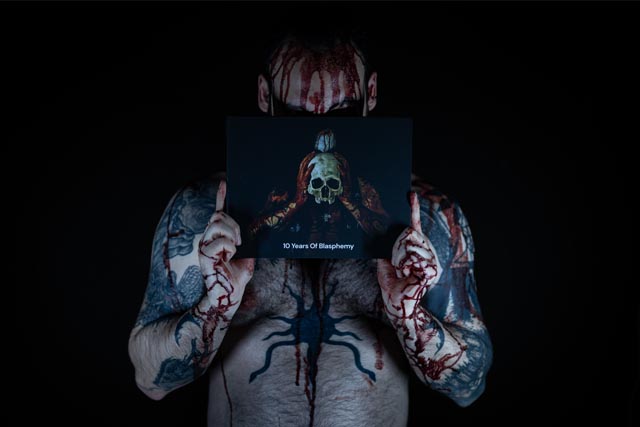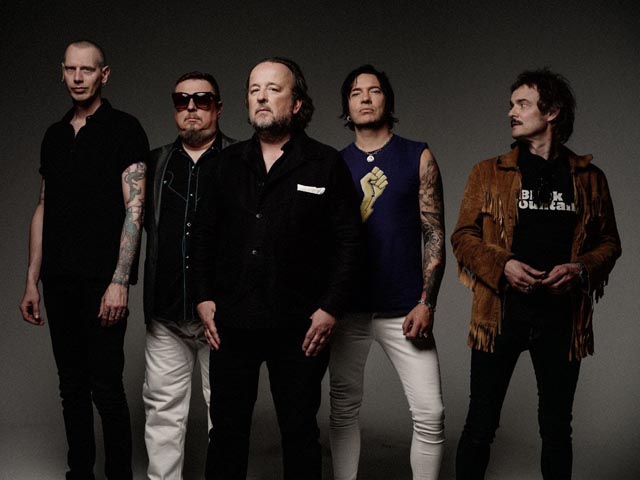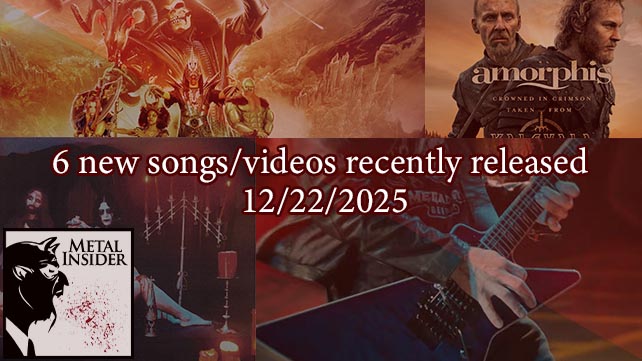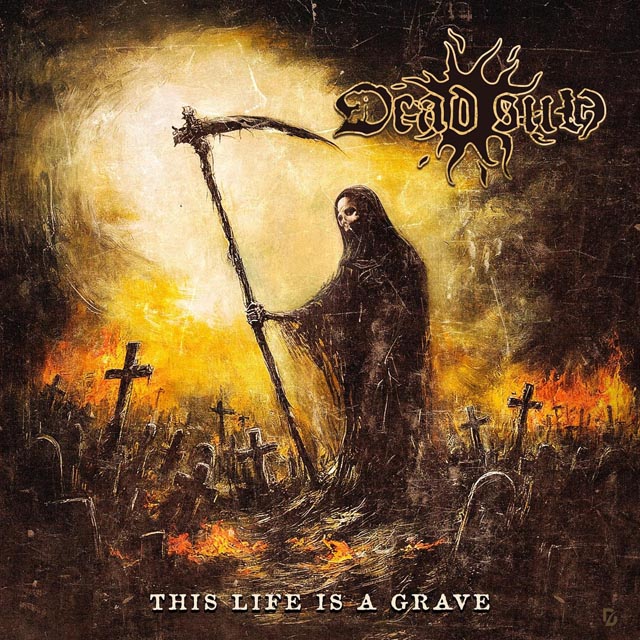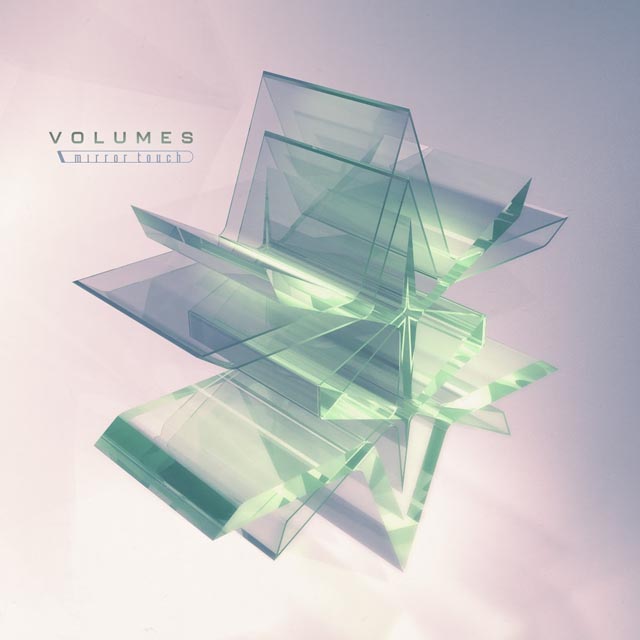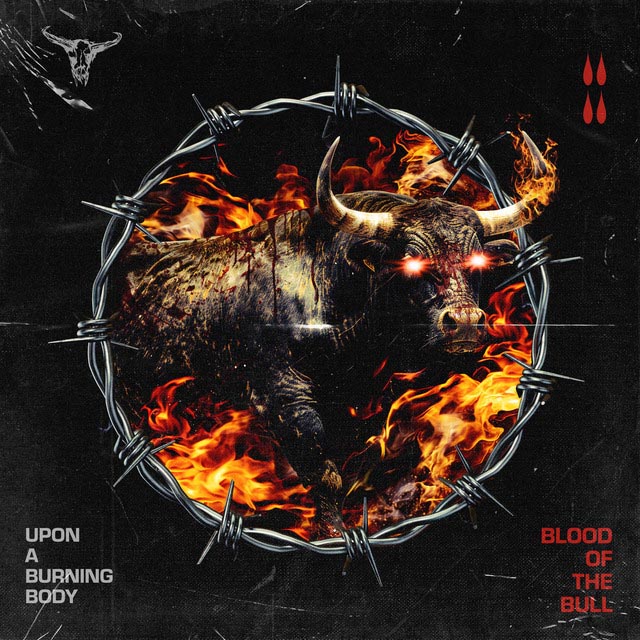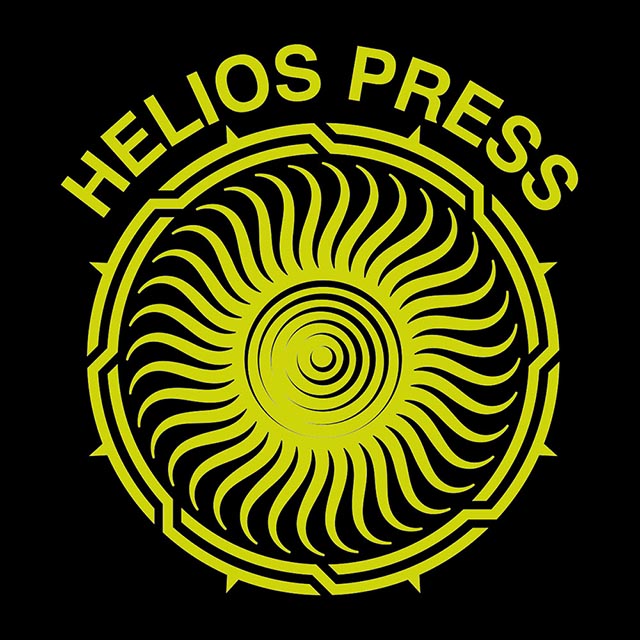
Yosuke Konishi, the founder and owner of Nuclear War Now! Productions, is revered as a staple within the extreme music scene. With NWN!, Konishi has released and reissued content by bands, such as Blasphemy, Black Witchery, Morbosidad, Abagail, Diocletian, Beherit, Von, Sadistik Exekution, Carpathian Forest, Kat, Morbid, Nifelheim, etc. Top names opt to collaborate with Konishi due to his stellar reputation and work ethic. Konishi brings all of his passion and perfectionism to his profession. He is likewise known for his innovation. One of Konishi’s achievements has been popularizing “die-hard” special editions, taking a term that had been coined by Iron Pegasus Records and expanding upon the concept. Die-hard versions of titles are a great way to offer enticing bonus items to fans.
In January, Konishi delighted his followers by announcing that his new record-pressing plant, Helios Press, is currently under construction in Brady, Texas. He plans to officially open Helios Press for operations later this year. Helios will serve various genres. This factory will function as a much-needed addition to the music community, providing clients with true quality.
We are pleased to have had the opportunity to sit down with Konishi to discuss Helios Press, NWN!, and much more. Without further ado, we present the results of our highly informative conversation.
Congratulations on your new plant! Is there anything you want to say about your hopes for it?
The idea of starting a pressing plant is something that I’ve always wanted to do. Even before then, I flirted with the idea of opening up a printing shop. When I was still living in Oakland, I ended up buying like $12,000 worth of printing equipment, including a professional offset printer, paper cutter, digital printer, and stuff like that from a company that was going out of business. Back in Oakland, there was a company called 1884 Printing that I used to use for inserts and stuff like that. When they were going out of business, they just offered me almost everything, so I bought a whole bunch of stuff. I was in the process of learning how to use it. Somebody who used to work there was actually teaching me. But then, the pandemic hit, and he couldn’t come over to help me anymore, so the machines kind of sat around.
And then, we just decided to move out of Oakland because things were getting kind of crazy there with riots. You must know that during the pandemic a lot of people from California moved out because of the situation there. We decided to move to Texas, but we had limited time. We had a 6,000-square-foot warehouse in Oakland filled with records plus my personal belongings from the house. Actually, we pulled it off pretty nicely. I had to sell the house. I had to rent out the warehouse, pack everything, and organize freight trucks to pick them up. We ended up getting like seven freight trucks, a couple of vans, and we got it all over here. The printing equipment was too big and too heavy to fit on the truck, so I ended up just basically giving it away. So, that’s where the spark for manufacturing came about.
Printing was something I wanted to do. When printing didn’t work out, I was thinking maybe I could go into something else. Then, I visited a friend’s vinyl pressing factory in Italy. That really kind of lit the flame, so to speak. When I quit my job last year, I had been working for twenty-something years. I decided at that point that I wanted to have a secondary career within the music industry. So, I just cashed out my 401(k), took whatever savings I had, and I contacted a friend who was in the music scene as well — somebody I’ve known for a long time. He cashed out his Bitcoin. We pulled all the money together, and here we are.
At this point, we’re like three and a half months in. We have a building already. We actually straight up bought it instead of renting or taking out a loan because we thought the less financial liability the better in the beginning. We didn’t want to get a loan and then start having to pay for a business where there’s no revenue coming in. We just wanted to start off on a cash basis. So, we have a building now. It’s getting fixed up. All the insulation is getting stripped out. The roof is getting sealed. The pressing room has to get doubly insulated because we’re in Texas, and it gets really hot here. The press room has to be very well climate-controlled because the presses themselves are very temperature-sensitive. The ambient temperature and moisture have to be managed very carefully as well. Luckily, the building has enough room inside. It was being used as a cabinetry shop. So, the warehouse space is where they were building the cabinets. Then, they would paint them. And then, they would put them in this other bigger space. That kind of worked out perfectly because this other space is more built out, and so it’s easy to insulate. So, we’re just getting this building ready for the presses to arrive, which we’ve already purchased as well. We bought four presses from a German company called Newbilt Machinery. They make brand-new manual machines for vinyl pressing. So, we’re just waiting for them to arrive this summer.
Could you please tell me about the Kickstarter campaign that will be up soon?
We’ve taken the entire project as far as we can using our money. Now, we’re going to have to ask our supporters for assistance in raising the rest of the capital necessary to purchase the infrastructure that goes into building a factory like this. Vinyl pressing machines require hot steam coming from a boiler and cold water coming from a water chiller, so basically almost like air conditioning and heating… We need a lot of pumps and pipes, so there’s lots of engineering. All this costs like $300,000. The boiler and chiller themselves are roughly $100,000, just the machinery. So, with Kickstarter what we’re trying to do is to raise enough money, again, about $100,000, for the boiler and chiller. For the rest of the infrastructure, we will try to bootstrap together more money.
As you know, I have NWN! as my first business, so there are several levers that we can pull. There are special editions that we can do to try to raise money. We can run a sale. So, we’ll do all of these things to raise money. For the Kickstarter campaign, which will start March 1, we’ll probably do limited-edition records with special packaging — I’m thinking like sheet metal that’s laser-edged or chemically edged, just to make it very special for the campaign because not many people have done that. To go with the Helios sun, we will probably press the records on yellow vinyl with black smoke or something. The center label will have the Helios logo. We’ll do classics that I’ve done on NWN! like Blasphemy’s Fallen Angel of Doom… [1990], Conqueror records. I’m thinking like Goatlord, Sabbat, stuff like that. So, that will be the goodie stuff that you can buy. Essentially, Kickstarter is like a long-term preorder website. It’s nothing new to what I’m doing because we do preorders once in a while, not like one year in advance or anything, but that’s essentially what Kickstarter is for. So, we’ll do something a little more special for this like an insert with everyone’s name that contributed that will be included in the records that we’re pressing. Obviously like T-shirts and other merch.
I believe you said you want to serve a lot of different genres, right?
Right. Helios is a completely separate business from what I’m doing with NWN!, which is metal-focused. Obviously, I’ll press for NWN! and other labels I know in the scene. My clientele for Helios is probably going to be underground metal, punk, noise in the beginning. But we definitely want to expand outward and serve pretty much anyone. We prefer to work with independent labels and bands if we can, but we’re not going to say no to Sony as long as it doesn’t affect the timeline for the rest of the people in queue. That’s something that we really have to juggle because many other factories have this problem of taking on enormous labels like Universal or Sony and then just fucking up the entire pipeline for everyone else. That’s one of the things that triggered the entire idea of forming Helios. During the pandemic, other factories were getting clogged up by major labels. Taylor Swift is like 50,000 units or something. That just clogs up the entire factory for months or delays everything because we’re just small fish in a big pond. These enormous corporate-minded factories out there, they just want the money. They just want to get the bigger label stuff because they’re bigger volume. If you can just press one record over and over, it’s much easier to manufacture than if you have to change the stampers and communicate with different customers. There are a lot of overheads associated with working with smaller labels, but that’s exactly what we want to do. But yeah, we’re going to be genre-agnostic as much as possible. Even just like comedians, you know, they’re starting to press records, and I’m in Austin. The comedy scene here is pretty big, so we’ll probably press records for Tim Dillon or something if we can. I would love to do that.
Are you going to sell a lot of your records at Eastern Front, which you opened in 2021?
Eastern Front was actually in Oakland as well, but it didn’t get much traction because I was in the worst part of Oakland, East Oakland where people get shot if you’re not from there. So, we didn’t get too many customers in Oakland. But now that we’re in kind of like the suburbs of Austin right by Lake Travis, we tend to get a lot more customers walking in. We will press records specifically for Eastern Front as well, maybe special editions or something.
Would you like to talk about the importance of vinyl because I know you’ve been collecting records since you were eight years old?
I think there’s vinyl in my blood or something because it’s been something that I’ve been obsessed with forever. I turned 48 this year, so I guess I’ve been doing it for 40 years or something — just collecting records and listening to records. The reason why I think records have stuck around while other formats have kind of dropped off along the way is because I think there’s kind of a primal need that people have for physical media on a bigger format. They want to have the visual artwork to go with the music because. And then, there’s also written texts, so there’s also the literary art as well. It’s an art form that’s best represented in the form of 12” records, in my opinion. I think that’s part of the reason why vinyl has sustained its popularity for so many years.
CDs are kind of making a comeback now because of the recession. I think when vinyl prices go up and CD prices drop, people start to realize that maybe they can get two albums for the price of one. Of course, streaming is there, but that’s kind of a passive and pedestrian way to consume any sort of art form. Anything that you do online is just a passive activity. You may not even remember it the next day. I do plenty of passive listening when I’m working, but when I really want to listen to music carefully, then I put on a record. You really have to pay attention too because you have to flip them. The cool thing about records is that it’s a linear listening experience. You cannot jump around from track to track like you can on a CD or some other digital streaming platforms, where you can easily skip through the songs you may not like.
The artists, if they’re good, composed their work as an album. It’s a totally different experience to listen to Black Sabbath’s Paranoid [1970] from beginning to end rather than just playing “Iron Man” or something. On the radio, they just play “Iron Man,” but in fact the entire album is great, and that’s how the artists intended for the music to be listened to. There’s a lot of craft that goes into writing an album. You usually want the first side to kind of go down and then pick up again on side B. So, that’s usually how it’s written. And then, it ends strong with a very great closer. That kind of thing is only possible on an analog medium like vinyl or tape or something.
Tape sort of came back for a little bit, but it’s dropping off now again as people are realizing that it’s kind of a stupid format. There’s a lot of hissing on tapes, and they’re not that cheap anymore. They used to be super cheap, but the factories caught up with the demand, so they raised their prices.
Obviously, you have a great sense of aesthetics, so would you like to speak a bit about how the artists in your family influenced you?
I grew up in a family of artists, graphic visual artists. My mother was a lithograph artist, and that’s what I grew up around. Japanese houses are really small, and, in our living room, there was this huge lithograph machine that took up almost the entire space. Every morning, I would sit down at my dining room table, and there would be this enormous lithograph machine to the right. The entire house would smell of printing chemicals and ink. So, I was exposed to that from pretty much day one. My father was a woodcut artist, traditional Japanese style. His father was actually a woodcut artist. He was very famous in Japan. During the Soviet era, he went to Czechoslovakia, and one of his pieces ended up on a stamp or something. We have it archived somewhere.
And then, my two sisters ended up becoming visual artists as well. My older sister, Mana, is now a professional painter in Tokyo. She does oil paintings, mostly portraits and landscapes and stuff like that. And then, my other sister was doing lots of photography and pottery in New York City. She ended up moving to Okinawa, which is one of the smaller islands off of Japan, but not the main Okinawa area — she ended up on a tiny island with only 300 people on it.
So, I was thinking the other day — my entire family ended up just working for themselves and doing something very artistic. I was never a visual artist per se, although I guess I have an eye for aesthetics. I’m okay with graphic design and stuff like that. When some band gives me cover artwork that I think is shit, I will let them know because that’s going to be to their detriment once the record comes out and to my detriment too if I have to release it.
I’ve seen that 2001 is often given as NWN!’s year of formation. However, you’ve stated that you’ve been running the label for 24 years.
So, 2000 is essentially when it started. It started out as a hobby. The first three releases were kind of bullshit. The first two releases were from a noise metal project, Erebus, that I was doing with my friend Jason. He just recorded some tracks, and I recorded vocals over it. At the time, we were listening to a lot of Japanese noise and really minimalist black metal from Norway like Ildjarn. This was like 1999/2000. We were both in college. He was living in Virginia. I went to Virginia Commonwealth University, which is like an art school. It’s like a backup school. For the first two years in high school, I fucked around listening to metal and skateboarding, so I couldn’t get into a good school. So, I went to VCU for two years, and I met my friend Jason there. Then I kept my grades up and got my act together because I really wanted to become a physician back then.
So, I went to UC Berkeley and studied biology. While I was living there, I was still corresponding with Jason. We would tape trade. We had this idea to create a remote band, and it never really worked out. So, release number three on NWN! was a bootleg recording of Enslaved from Norway. So, I made a CD-R release of just twenty copies with a handmade cover of a recording I made with just a field recorder. You can see that I was not really serious about the label back then. I already had a logo and stuff. It was like a fun thing to do, and I was going to do more tapes.
But then, I was right out of college, and in 2001 I was working for a biotech company called Silicon Genetics — they were making software for gene expression analysis and stuff like that. So, I was working for them teaching software to scientists, and they would just send me to different states in the US. They sent me to Chicago one time, and I taught a class there. Metal Haven was just starting to open up. It was a pretty famous metal institution. I met a lot of different people on that trip.
The interesting part is that on the way back from Chicago, my flight got cancelled. The airline gave me a voucher for any flight within the US within six months. So, I had this flight, and then Blasphemy started playing live again. One of the first shows was July 13, 2001. I was already talking to Ryan Förster from Conqueror. He ended up joining Blasphemy around that time. So, I was talking to him, and he told me about the gig that was happening in Vancouver. I checked the voucher. At the time, I was poor as shit because I was just straight out of college and starting a new job. It was just by dumb luck that I had this voucher, otherwise I couldn’t have gone. So, I used the voucher to go to Vancouver, and I brought my field recorder. That’s how I got Blasphemy’s Live Ritual [2001] recording, and that was how the entire label basically started.
Speaking of Blasphemy, you, of course, organize Never Surrender Festival in Germany! The 2023 edition looked fantastic. This April, NWN! and Hospital will bring audiences Hospital Fest with both Beherit and Blasphemy on day one. Beherit’s Nuclear Holocausto Vengeance will give another performance, a solo electronic/noise set, on the second day. What are you most looking forward to about that fest?
That festival in Japan came about because I was talking to Dom [Dominick Fernow] from Hospital [Productions] and Departure Chandelier. We were saying it would be so cool to do a festival or a gig or something in Japan. We kind of started talking about it a little more seriously. I talked to Blasphemy. He talked to Genocide Organ. We kind of had a backbone for the festival between those two bands, but it wasn’t enough of a draw to make it a special event. Putting on a gig in Japan is super expensive, so it has to be over the top. He contacted Massona. Massona hadn’t played in like a decade or something. And Beherit, at the time, had never played actually outside of Finland, which is crazy. They were also broken up as a live band for many years. I mean, obviously, they just played in Oulu. But before that was announced, Osaka would have been the first metal performance… It’s still going to be the first metal performance, I think, outside of Finland before April…
Anyway, I was working with Marko [Laiho] / Holocausto for the reissue that I was doing for Beherit. We’ve had mutual friends and stuff over the years, so it was pretty easy to ask him. But what was interesting was I had a list of cities that I wanted to book Beherit in because I knew they were starting to rehearse. Juha from Witchcraft is also the guitarist in Beherit, so, again, I had multiple connections to Beherit. So, I knew what was going on. I asked Marko about Austin obviously because I’m from here. That kind of provoked a lukewarm response from him. And then, I asked him about Australia because I have contacts in Australia. He said: “Okay, maybe. Australia sounds interesting.” And then, as soon as I said Japan, he was like: “We’re in!” Marko is really into Eastern philosophy and travels to India and Malaysia a lot. I guess he’s never been to Japan before. I think he agreed partially because of the lineup because he’s into noise and experimental music. I think the idea of half metal and half experimental/electronic music appealed to him on top of Blasphemy playing and stuff like that. It was an easy yes from his side.
There are so many great titles available right now through your webshop. I was excited to see releases by Shining, Manii, Dissection, Knokkelklang, Skuggeheim, Selvhat, even the Russian heavy metal band Aria. If you were to choose some albums for me, which ones would they be?
I feel very lucky because I’ve gotten to release a lot of my favorite records over the years. Fallen Angel of Doom…. was something that I was listening to as a high school kid, and now Blasphemy’s on my label, and I press Fallen Angel of Doom…. records. And the same with Beherit as well. I grew up listening to Beherit. Drawing Down the Moon [1993] really means a lot to me. I got to do the 30-year-anniversary editions of that and The Oath of Black Blood [1991]. So, I can just give you my top albums of all time.
I should preface by saying I’m excluding all of the stuff that’s essential for everyone like Black Sabbath, Motörhead, Bathory, and Venom.
I guess number one would be Sarcófago’s I.N.R.I. [1987]. I think that’s one of the most important extreme music recordings of all time. I don’t think anybody’s actually touched it. It’s a timeless classic. The visual aesthetic they created, the spikes and the corpsepaint and everything, that’s pretty much the blueprint for all of black metal from thereon out. Anywhere from Norway to Singapore to Canada, everyone was influenced by Sarcófago’s sound and visuals.
Number two — maybe Blasphemy’s Blood Upon the Altar demo [1989].
Number three is Beherit’s Drawing Down the Moon. They really perfected atmosphere and bestiality on that record. Perfect mixture of what Blasphemy created along with Beherit’s own spooky, whispery vocals and ambiance that Blasphemy didn’t have. Beherit really came to their own sound on Drawing Down the Moon, and you can really hear Marko’s genius on that record.
Number four — I guess I would have to go to my countrymen, Sabbat’s Envenom [1991]. The songs are so well-crafted on Envenom. It’s a perfect mixture of extreme metal and heavy metal roots. You can really hear the guitar riffs shine on a song like “Devil Worship.” It’s a perfect mixture of like Vemon, the New Wave of British Heavy Metal, and then extreme metal.
Next one — Messiah’s Hymn to Abramelin [1986]. That one’s always categorized as thrash metal, but it’s a lot more than that. For an album that was recorded in ’86, it’s ultra-extreme. I like all the quirkiness too, all the talking between songs. And they also came up with the spikes and the corpsepaint and the barbed wire onstage. That was pretty extreme for Switzerland. I don’t even know where they got it from, maybe Sodom or something. And I would say Sodom should be somewhere on the list too, but Sodom, Kreator, Iron Maiden, and Judas Priest are already in the bucket of must-haves.
Sarcofagus’ Envoy of Death [1980]. That’s a Finnish heavy metal record, but it’s way ahead of its time. They have a very distinct sound. For some reason, they came to their perfect sound on their second album instead of their first kind of like Beherit, but The Oath of Black Blood is more of a compilation than an album.
Thank you for the wonderful interview. Do you have any closing words?
Kickstarter starts March 1. Everyone can follow the progress of Kickstarter and everything around it on Instagram. We created a separate account for just Helios, it’s @heliospress. I’ll post updates on both going forward. Right now, we’re building the Helios Kickstarter page. It’s starting to look pretty good. We made a professional video.
So, for the Kickstarter campaign, we’re doing a gig in Austin. It’s on May 4. It’s a Saturday. A bunch of Texan NWN! bands are playing — Morbosidad, Imprecation, Trench Warfare, True Iron Will. Ares Kingdom from Kansas City is riding down for that as well, so that should be a good time.


